Devinci Dixon RC Review
TESTED
DEVINCI
DIXON
RC
DIXON
RC
BY BRAD WALTON
The six-inch travel bike should be the most versatile steed in one's fleet. It's the Swiss-army bike that blurs the line between capable climber and confident descender. Modern references that come to mind include 'All Mountain' and 'Trail Bike'. While these terms generally lack any sort of absolute definition, there is one thing that sets this style of bike apart: its round-trip efficiency.
Devinci's Dixon RC is designed to take riders up, down, and all-around the mountain quickly and comfortably. Tipping the scales at just under 30 lbs for our large sized test bike, and boasting 5.7" travel, the mid-level RC is well-equipped to cover the variety of terrain one would encounter while riding the whole mountain, bottom to top to bottom.
Devinci Dixon RC Details: • Purpose: All-Mountain • Devinci G4 aluminum triple butted tubeset • Rear-wheel travel: 145mm/5.7" • Adjustable geometry • Tapered head tube • ISCG-05 chain guide tabs • 12 x 142mm thru-axle • Split Pivot concentric axle pivot • Made in Canada (lifetime warranty) • Fox air suspension front and rear • Weight: 29 pounds (w/o no pedals) • MSRP: $3999 USD | Dixon's Construction Devinci's G4 aluminum tubeset is triple butted, which means the tubes are thickest in areas where strength is key and thinner in less vital zones, allowing for weight savings. Further strength is gained by hydroforming the 6066-T6 aluminum tubes into the pyramid shape you see on the top and down tubes. Devinci welds and heat-treats their frames before machining the bearing seats into the pivot points, thereby eliminating the chance of frame deformation due to the intense heat of welding. This should in turn increase bearing life in the frame by ensuring that frame alignment is free of axial loading to the bearings. A Cane Creek Zero Stack headset locates the headset bearings inside the frame's tapered head tube. Shaped top and down tubes are able to utilize the added real estate offered by a massive head tube for an assuredly solid connection during the manufacturing process, which, by the way, is done entirely in-house in Canada. |
Dixon Suspension
Intelligent Link: Devinci's Intelligent Link features pivot hardware that allows you to adjust the bike's head angle by half a degree by simply rotating the gold anodized aluminum insert at the seat stay and rocker link joint, and the bike's Fox Float RP2 rear shock is mounted to the Intelligent Link and the front triangle - it doesn't 'float' as on other designs. Use of a stock, non-modified shock is allowed thanks to the well-tuned leverage ratio integrated into the DW-inspired Split Pivot suspension, meaning that the damper doesn't require any valving trickery to get the most out of the design.
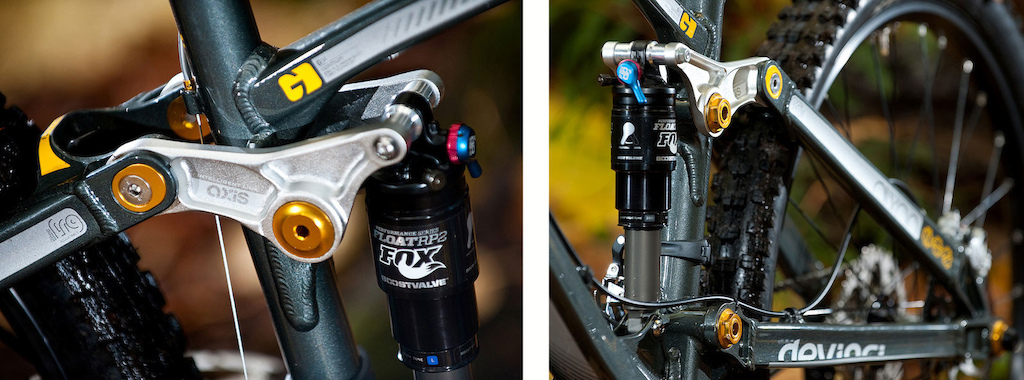 |
 Devinci's Intelligent Link (left) features pivot hardware that allows you to adjust the bike's head angle by half a degree. Devinci's Intelligent Link (left) features pivot hardware that allows you to adjust the bike's head angle by half a degree. |
Split-Pivot: The heart of Devinci's mountain bike line-up is the Split Pivot, a concentric pivot that rotates around the rear axle. Split-Pivot suspension promises minimal user input into rear suspension actuation by isolating pedaling and braking forces while climbing and descending - the concentrically-located Split Pivot is engineered to reduce excess suspension reaction to acceleration and braking forces. Devinci's frame bearings are MAX-type bearings with water-resistant grease and weather seals, and are further protected with anodized aluminum accent caps that serve to keep the muck out.
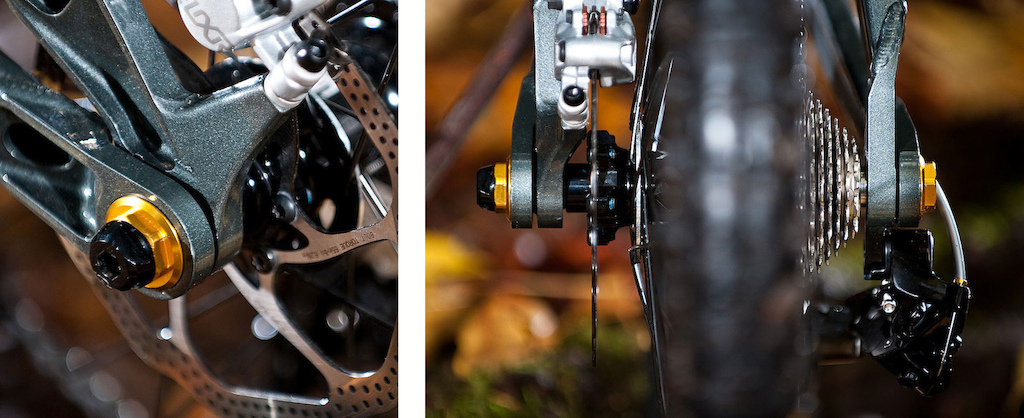 |
 Split Pivot concentrically rotates around the rear wheel's 12mm thru-axle, working to neutralize braking forces to the suspension. Split Pivot concentrically rotates around the rear wheel's 12mm thru-axle, working to neutralize braking forces to the suspension. |
Geometry
Blending light weight and efficient pedalling characteristics into a bike that is also stable at high speed and confidence inspiring on technical descents is the difficulty in designing a bike meant to do a little of everything. The geometry of the Dixon has been carefully planned out to give the rider the best compromise. A 'high' and 'low' adjustable setting for the Dixon allows a rider to fine-tune geometry between XC-oriented trails or those of a more technical nature. On paper, it certainly appears a capable machine.
Dixon RC Component Check
The Dixon RC's component roster is chock full of lightweight, high-performance bits, such as Fox air shocks fore and aft, Easton Haven stem, bar, and seatpost, Sram X9 derailleur, and Mavic rims. There isn't much compromise to be seen, with every part selected to meet the Dixon's role as a full-time performer.
| 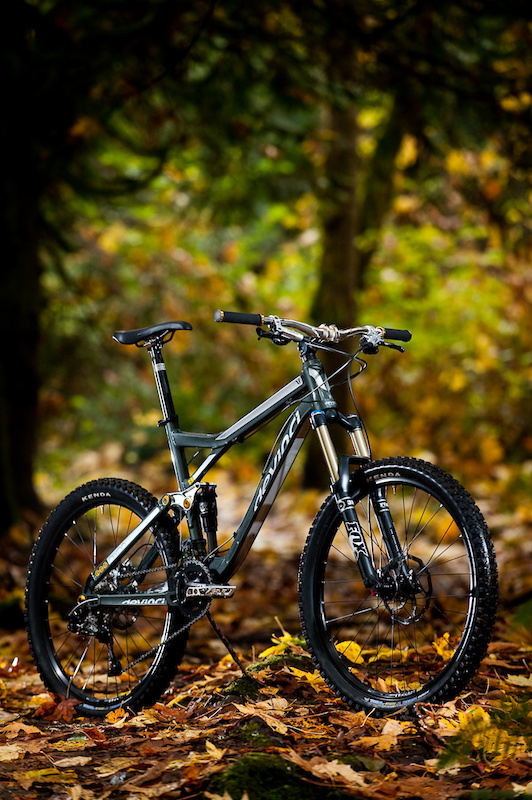 | |||||||||||||||||||||||||||||||||||||||||||||||||||||||||||||||||||||||
Riding the Dixon RC
First impressions: As the industry moves forward, pushing more travel with lighter weight as being better, 'all-mountain' has become an increasingly ambiguous nomenclature. It is of no surprise that initially the Dixon RC gives off the vibe of being a lazy man's cross-country bike due to having a 90mm stem attached to a lightweight 145mm chassis. Although well-suited to keeping rider weight over the front end for aggressive climbing, the stem length interferes with the cornering ability of the Dixon when it comes time to reap the rewards. The stock Dixon is set up correctly for rolling, non-technical terrain, but our time on the Pacific Northwest's undulations of a higher magnitude led us to believe that a few simple spec changes could unleash its potenial on the more demanding terrain that the bike was tested on.
Swapping the stem to a 70mm, nearly one inch shorter, yields a slightly more aggressive riding position and opens up a new realm of possibility. The Dixon now resists that unsettling over-the-bars feeling, and steering goes from skeptical to predictable. A slightly wider bar also bumps up front end stability significantly. With the basics covered, we now had a shred-ready, 145mm bike capable of efficiently conquering the entire mountain.
Fit: A 24" top tube has become somewhat of a standard for large sized bikes, and there's a good reason why. The decision to change stem length was completely due to sloppy steering characteristics rather than fit issues. The large Dixon allows ample room to relax on climbs for a 6'2" rider, yet still maintains a neutral body position all around. The option to drop the saddle via full-length seat tube was utilized plenty. The Dixon's seat angle isn't drastic enough to feel like we were reaching for the pedals, which is key to keeping the front end in check on the climbs. We found preference in the 'Low' geometry setting, putting the cranks closer to the ground and slackening the head angle to a comfortable 67 degrees.
Climbing: The 'Low' geo setting didn't seem to hinder climbing ability much, although there was some compromise with the shorter stem in the uphill department. A tendency to want to stand while climbing the steeps had us thankful for the Fox 32 fork as opposed to a stouter, taller option. Bottom bracket height was suitable for cleaning technical climbs without pedal strike. The Dixon feels balanced without exhibiting any top-heavy characteristics, even at full seat post extension.
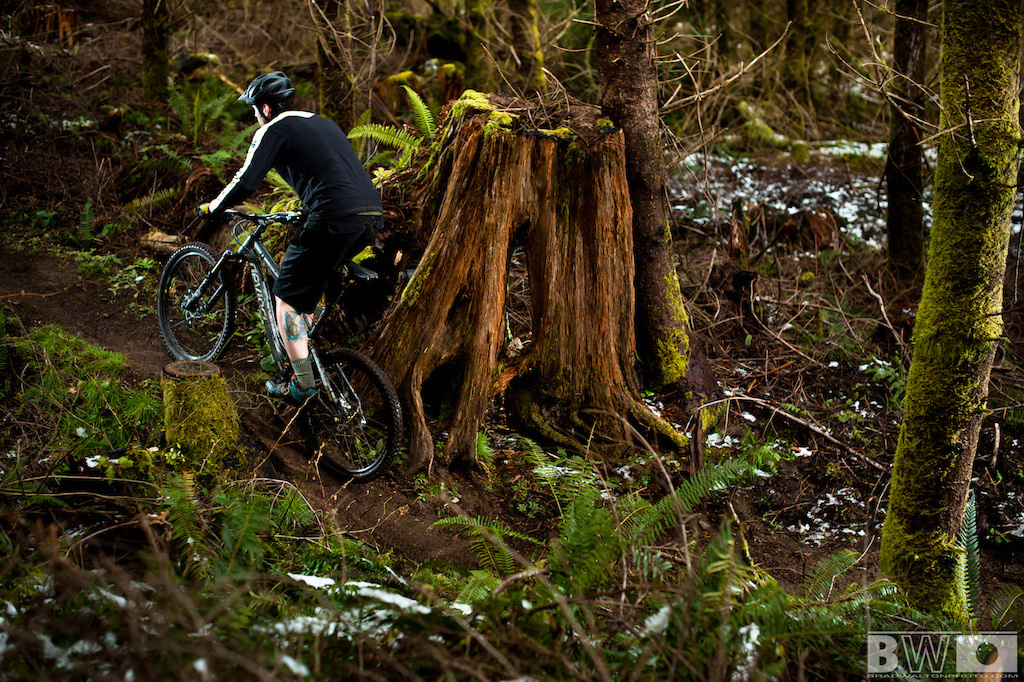 |
 The Dixon climbs easily and predictably, especially thanks to it's light weight. Shock lockouts were never needed during the test. The Dixon climbs easily and predictably, especially thanks to it's light weight. Shock lockouts were never needed during the test. |
Handling: The Dixon's light weight is immediately apparent. The bike is quick and nimble full-time, and a real pleasure to pedal. While welcome on the climbing portion of the ride, the bike's light weight causes it to ricochet off some obstacles that aren't approached in a head-on fashion. This is especially apparent on rocks and diagonal roots, so the rider needs to stay on point in rough terrain and remember the utility of a lightweight 145mm travel bike is a compromise which isn't entirely gravity-oriented.
The bike's component spec may lead it down the smoother path, but its geometry points to its true classification. A 67 degree head angle makes for relaxed descents, while the sub-17" chainstays are highly responsive when exiting corners and allow easy maneuvering for the front end. We found the bottom bracket height sets up an ideal pedal location in the slacker geometry setting. It's solid middle-ground between getting low and stable versus banging pedals. This is a very important trait for bikes of this genre, as riders will find themselves pedaling over rough terrain just as much as coasting over it.
The Dixon certainly excels in a high-speed environment. The suspension works better the faster a rider is willing to push it. We also found the bike's light weight combined well with the geometry to offer great technical handling attributes. Slow-speed negotiation is a breeze with the bike's light feeling front end, which isn't exclusively due to fork selection. The short chainstays make for a highly flickable, fast, and fun bike in nearly all situations.
 |
 The Dixon handles the slow-tech creep just about as well as it does at warp speed thanks to a progressive geometry. The Dixon handles the slow-tech creep just about as well as it does at warp speed thanks to a progressive geometry. |
Suspension: The Dixon geometry feels comfortable once gravity takes over, but it does have the feel that something is being compromised. 32mm fork stanchions were never a problem way back when max travel was 3", but with the amount of travel doubled for modern day standards, flex was definitely notable in the rough stuff. Not that it was terrible, just worth a mention. The Fox Float 32's performance was smooth and supple throughout the range of travel. From small bump chatter to full compressions, the little air fork's ability to dampen the entire gamut of terrain encounters while remaining at a proper ride height and resisting harsh bottom-out is impressive. A stouter fork would benefit heavier riders or those looking for a more aggressive setup by not only offering more rigidity up front, but also raising the axle-to-crown height, effectively providing greater steering stability when the going gets rough. As stated earlier though, a taller, slacker front end will detract from Dixon's climbing prowess. Riders looking for a fast bike in rolling terrain are all set with the stock Dixon. If, like us, your typical ride is sustained up followed by sustained down, you may opt for a more robust front end for added confidence.
Split Pivot suspension is touted as brilliance when it comes to the 'all mountain' genre of bike. We found this to be so true that we don't have much to say about the bike's rear suspension. It works, all the time. Even for prolonged bouts of exertion, we never felt the need to reach for the shock lockout. Riders will not notice the rear suspension doing half the work while hammering the roughest of singletrack. The Fox RP2 feels smooth and supple as a perfect mate to the Float 32 fork. While these mid-travel absorbers certainly take the edge off, don't expect the ability to plow the chunder. Line selection is still as important as ever on the Dixon, but there is a nice bit of cushion back there to smooth over square edged hits with minimal input from the rider. We ended up slightly under-pressurizing the RP2 to get the supple feel we expected from the bike. A 200 lb rider would greatly appreciate a low-speed compression circuit in the rear shock - we tended to use every bit of travel in the corners - but this highlights the balancing act that companies must perform when deciding the component selection of a mid-range bike. With enough air pressure to prevent this, the rear end doesn't match the suspension rate of the fork properly, resulting in a forward body position and harsh deflection off nearly every obstacle.
Pedal or brake induced feedback to the rear suspension went unrecognizable. Split Pivot took care of keeping things active, while the Intelligent Link kept suspension stiff and responsive when the going got fast. The fork wasn't the only place flex was detected aboard the Dixon, however. The frame feels very stable and predictable in hard corners, but suffers from tire rub on either chainstay. It is likely down to the combination of large tires on lightweight wheels, or it could be in the frame itself. Either way, it wasn't felt, just heard. The Dixon exhibits a very positive snappy feel out of corners. It begs to go fast and effortlessly air over the slightest terrain nuances.
Technical report
• Water bottle cage mounts are appreciated spec on a bike made to go light and fast. It's awesome to get away with riding sans backpack.
• Easton's Haven components, while looking the part, seemed mis-matched to the rest of the Dixon RC. As a stock bike, the Dixon feels like a true XC bike due to the 90mm stem and 710mm bar. We replaced the stem with one an inch shorter and the bar with one an inch wider. This setup complimented the bike's geometry and opened up its capabilities tremendously, but it does need to be said that Devinci must spec the bike for the entire world and not just aggressive riders who prefer a shorter cockpit. Much like a saddle, a good bike shop should get you dialed with a stem length that suits your style and terrain before the bike goes out the door.
• Sram's 2 x 10 gearing is spot-on for the Dixon. With such a large range in the drivetrain, there's no excuse to ever walk a climb or get passed on a fire road segment.
• Devinci specs a great chainguide mounting solution and includes an ISCG adapter as stock, hidden behind the crankset. It's a good thing too, because you're going to need it. The Dixon throws chains both inside and outside of the 38-tooth ring at least once during pretty much every ride. We installed an E.thirteen DRS which required some modification to fit, and proved to help but not fully alleviate the problem. We'd like to see Devinci spec a dual ring guide with Dixon.
• Kenda's Tomac signature Nevegal DTC tires are a perfect match for Dixon's intentions. Durable 60 durometer rubber in the middle wrapped in softer 50 durometer side lugs help the Nevegal to roll pretty smoothly for a 2.35" tire. We found it slightly sluggish on sustained gravel road climbs, but once trail speed ensued the Nevegal felt confident and predictable in nearly all conditions. The medium height, square profile of the knobs offer great traction for both climbing and braking on softer pacific northwest trails, and the softer side lugs were certainly appreciated when negotiating root sections. Under hard cornering, the Nevegal held it's own, but did buzz Dixon's chainstays on a somewhat regular basis.
• Dixon could greatly benefit from a dropper-type post, and we were a bit surprised to not see one given the bike's intentions.
Pinkbike's take:
 | Devinci's Dixon RC strikes a balance somewhere between comfort cross-country and aggressive all-mountain. A light bike with 145mm of rear wheel travel and uncompromised geometry, the Dixon is fast and capable given a few personalized touches based on average terrain use and rider preferences. It's only limitation is how comfortable a rider feels when hard-charging rough terrain on such a featherweight bike. For the endurance rider, the Dixon is a dream come true with superb pedaling characteristics and relaxed yet quick handling. While it's no one-bike quiver killer, the Dixon is a go-to machine when efficiency is the goal for riding everything the mountain has to offer. -Brad Walton |
www.devinci.com
Author Info:
Must Read This Week
Sign Up for the Pinkbike Newsletter - All the Biggest, Most Interesting Stories in your Inbox
PB Newsletter Signup
-
About Us
Contacts FAQ Terms of Use Privacy Policy Sign Up! Sitemap -
Advertise
Advertising -
Cool Features
Submit a Story Product Photos Videos Privacy Request -
RSS
Pinkbike RSS Pinkbike Twitter Pinkbike Facebook Pinkbike Youtube Pinkbike Instagram
Newsletter Signup
Copyright © 2000 - 2024. Pinkbike.com. All rights reserved.
dv56 0.053198

 The Dixon's frame tubes feature extensive shaping to increase stiffness and strength.
The Dixon's frame tubes feature extensive shaping to increase stiffness and strength.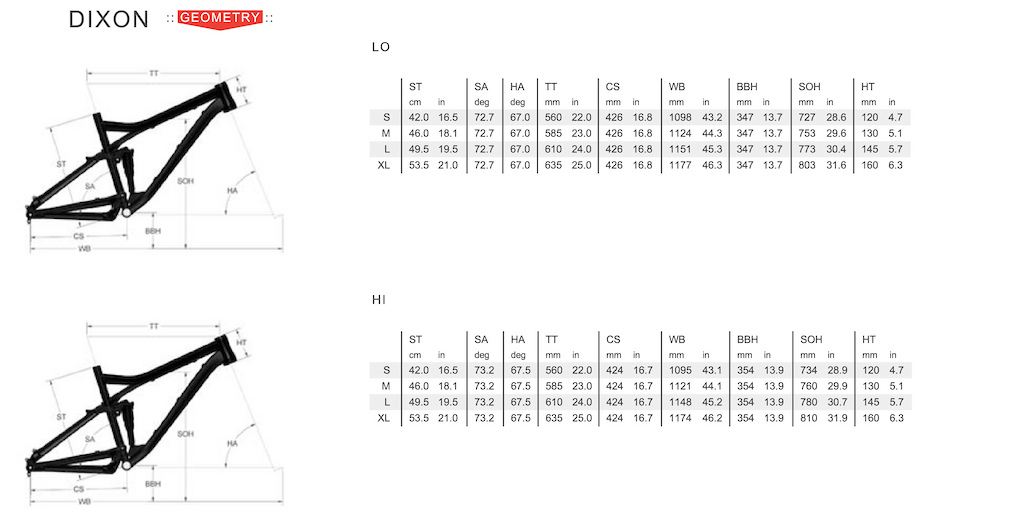
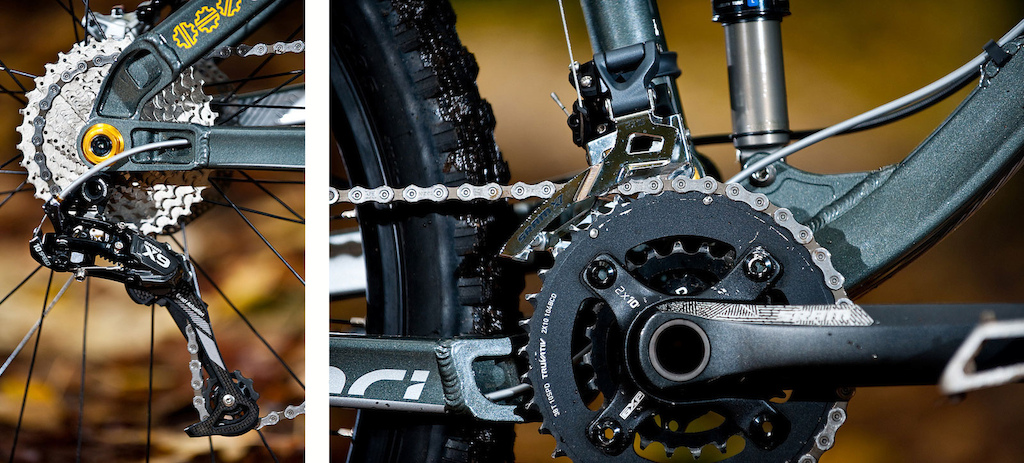

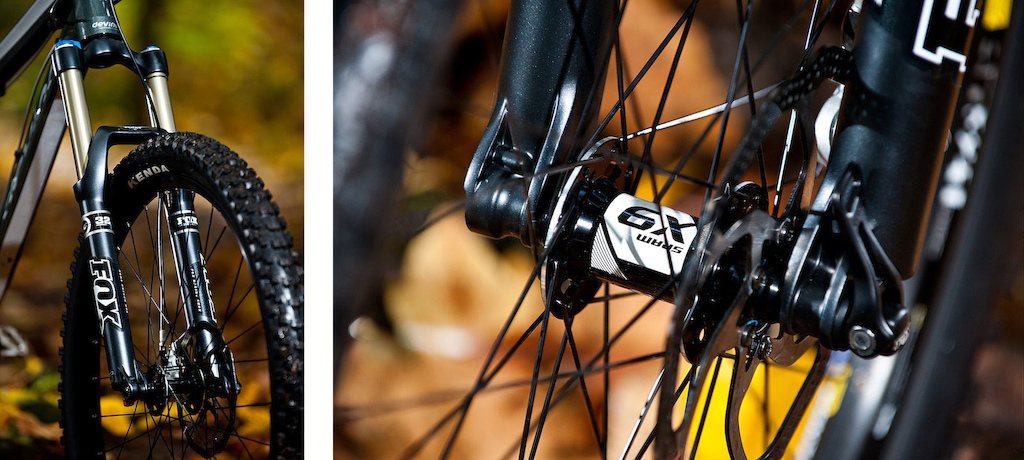

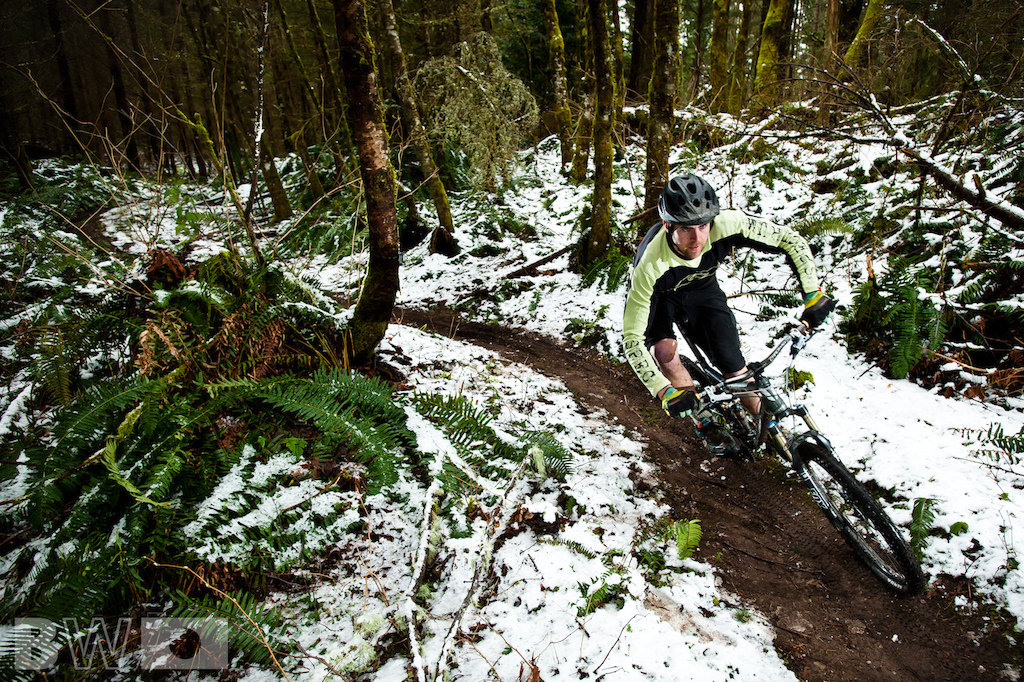
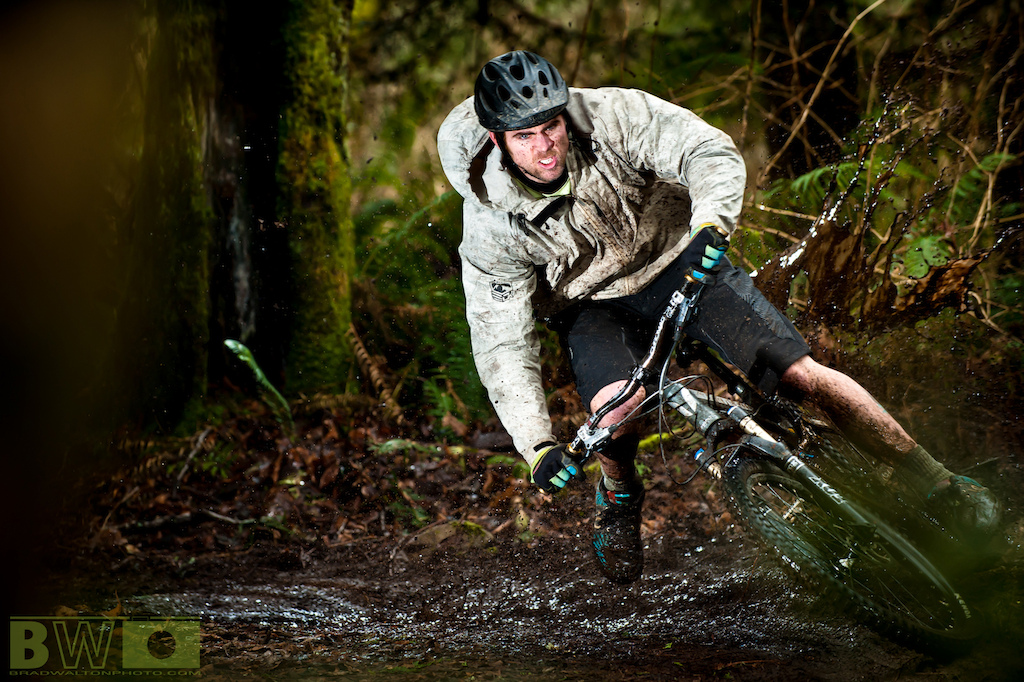

mtbleaks.wordpress.com/2011/12/15/fox-racing-shox-2013
back to the Dixon... I like this bike. It seems to be built with the east coast of NA in mind. Short ups and downs, rough and wet. When my 2005 Enduro finally gives up the ghost, this could very well be the frame to replace it.... Thanks for the review. Also, any thoughts about how this bike pedals over rough stuff in comparison to a DW-Link bike? I've heard that the DW-link stiffens up quite a bit while pedalling through rough terrain, and I'm curious if this is exhibits similar tendencies. thanks.
They only have 3 full sus mountain bikes. The dixon stands between the wilson and the dexter. The dexter already comes with a f32 100mm, I would have made a different choice for the dixon since it's for a different crowd.
taletotell: 32mm stanchion RS with 20mm TA are not limited to Psylo.... they are still making the Revelation and the Sektor with those specs...
If I was the king of the fork companies I'd set it up like this:
80-120 = 32mm
120-150 = 34mm
150-180 = 35-36mm
180+ = 40mm
This is probably what fox has in mind since the 34's will be out for 26" next year.
Any word on if the float 180 is flexy?
2) Is that supposed to be "undulating terrain"? You could happily ride a 100mm marathon bike along those highways.
2) Compaq - I had an alu trek remedy, which uses the same suspension design. It had a heavier buildkit than on that dixon (old xt, talas, dcrv shock, 3rings, bontrager heavy parts, in a larger size) and it hit the scales at 28.5lbs. With a lifetime warranty. And a frame that costs half as much. I'm sure it wasn't quite as durable; so maybe, in four years, I would have cracked a stay and the dixon would not have. But I'd still have a brand new remedy frame when I did.
3) Also, "plough through the stuff" - if there was any evidence that adding weight to bikes would make them easier to control and faster on the downhills; do you think that world cup downhill would be the weight game that it is?
the fact that it has 145mm doesn't necessarily attest to the bike capabilities.many riders build them with 160 forks. i haven't seen any stumpys with those.
as for the remedy, i dont know where on earth it costs 1000 usd for a frame (dixon=2000 usd). as for chainstays , well, every rider i know that rides AM with a remedy broke its chain stay in less than a year.this is in fact the reason they went 150 on it, cause its not that durable (although a good bike).
as for warranty, i advice you to read trek's (and specialized) warranty for rear triangles - far less than lifetime ! and the slash/session for example has a 3 year warranty only on the frame.
Are you in any way related to Wade Simmons? I bet that trail never realized it had so many jumps on it.
What do you all think? Would it affect the climbing too much? Or is it a good choice to keep its all around style (up and down)?
Thanks!
the larger 36 fork felt better (fitted the stout nature of the frame and very capable rear suspension) than the Dixon I test rode with 32 fork, and the 36 gave slacker 66 degree HA whilst having minimal effect on SA, BBH
trimmed the BB to 71.5mm to properly fit an E13 ISCG adapter plate by re-shimming the Shimano HT2 crankset, ran the E13 LG1 with a 1 x 9 setup which worked great
ep1.pinkbike.org/p4pb7329506/p4pb7329506.jpg
very, very capable bike both climbing and descending, mine was 31lb with the Reverb post and a sensible build (no carbon or bling..)
it was actually too capable for the XC trail riding I was regularly doing (with the rare uplift day or DH race) and made my riding boring!!
so I sold it after one year of ownership, and bought a 29er hardtail (stumpjumper evo) but that is not to take anything away from the Dixon, more of reflection of the reality of my day-to-day riding
But, If I was in the market for another 150mm / 160mm FS the Dixon would be my primo choice, no doubt!
for an aggressive rider, I would seriously recommend tuning the Fox Float shock with the Fox air spring volume tuning kit using the medium spacer
I ended up sending the shock to mojo for a retune - the light compression tune was upped to a medium and the boost valve pressure upped from 150 to 225 with the pro pedal also adjusted to suit. This transformed the ride and I've been running the shock at 30% sag without having to resort to any volume reduction spacers. The thing I don't understand is why the shock has such a light compression tune in the first place.
just before I left Freeborn we were starting to install the Fox Air volume spacer kit on the Dixon shocks, often with the "medium" volume spacer
this alleviated the issue of the shock being too linear in the mid to end stroke whilst not affecting proper sag, its also a problem common to the Specialized Enduro with the RP shock, where many Enduro riders use the "high" volume spacer
Dave Weagle (DW) designed the "tune" on the stock Dixon to be quite soft as the bike was originally intended as a pure trail bike (hence the lack of ISCG tabs on the first season models) before riders realised how capable the Dixon was in terms of slack geometry (for example 66 degrees with fox 36 160mm), great suspension performance and frame toughness for more aggressive riding
from discussions we had with DW he recommended the Fox air volume kit as an ideal solution for heavier or more aggressive riders
im finding it hard to believe the famed dave weagle will endorse a suspension set up with those issues.
I rode a Dixon RC last year and I was very impressed with its climbing power, but even more by its descending capability. With meatier tires, shorther stem, wider bar and a Reverb, the bike truly came to life in Bromont and our local singletracks.
If you want to demo one, Le Yeti in Montreal have some.
With 5k$ I ended up with a dixon rc on a better custom wheelset, x9 drivetrain, fox36s, carbon bars bla bla bla.
I already own a dh rig so I don't think I'll miss the extra 7.4mm of rear travel I would have gotten on the yeti. Wasn't worth the premium for a lesser build imo.
BTW my large Dixon RC out-of-the-box weighed just over 28lbs....
ps I ride a Scratch now, and thankful my remedy cracked because some "burl" is required for tougher trails:-)
ride on!